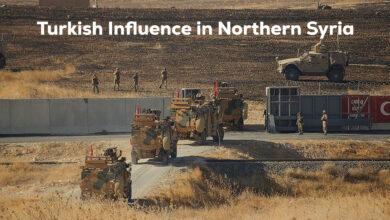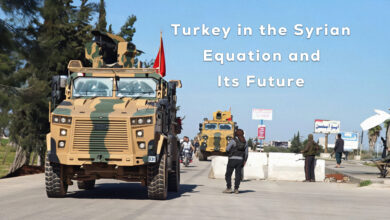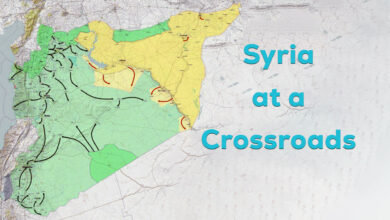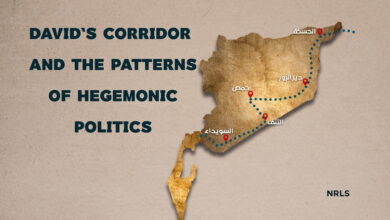The Israeli–Syrian Relationship in the New Era
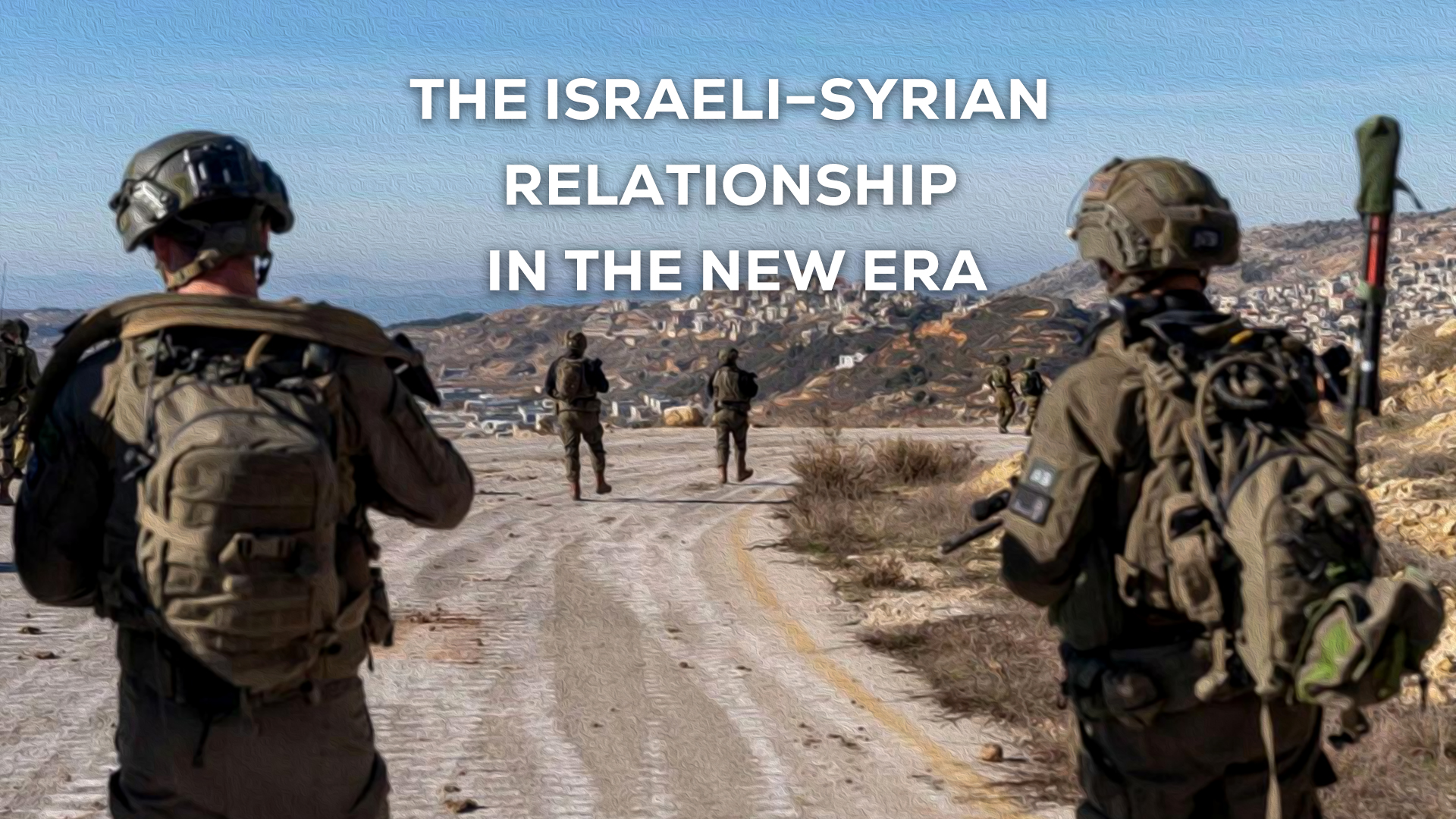
The former regime did not pose any real threat to Israel, despite being part of the so-called “Axis of Resistance.” However, it possessed several leverage points that allowed it to exert pressure on Israel, such as its hosting of Palestinian jihadist movements—particularly Hamas—its strong ties with Lebanon’s Hezbollah, and its possession of biological and strategic weapons stockpiles, air defense systems, and a conventional army.
Yet, the Syrian crisis exposed the falsity of the regime’s claims of belonging to the “Axis of Resistance,” revealing that its army and weapons existed solely to protect the regime and suppress the Syrian people. It also became evident that the regime’s downfall would not have occurred until the West and Israel were convinced that it could no longer escape Iran’s influence and had become completely subservient to its agenda—a situation that the West viewed as a threat.
As for the relationship between the former regime and Israel, it remained stagnant since the last round of negotiations between Hafez al-Assad and Israel, held under U.S. sponsorship during Bill Clinton’s presidency (1999–2000). Negotiations between Bashar al-Assad and Israel also continued intermittently but away from the public eye and under American mediation. The outbreak of the Syrian crisis, however, brought an end to U.S. sponsorship of these talks during Barack Obama’s presidency. Shortly before the regime’s collapse, Assad attempted to reach out to Israel in hopes of halting the advance of Hayat Tahrir al-Sham, but his efforts failed after the West—namely the United Kingdom, the United States, and Israel—decided to bring down the Syrian regime.
Syria in the New Era
Since its formation, Hayat Tahrir al-Sham (HTS) has claimed that one of its principal goals was to keep its “eyes on Jerusalem” and to liberate it from the Israeli entity. The group exploited religious and emotional rhetoric to build a popular base and attract fighters to its ranks. However, from the very first day following the fall of the former regime and HTS’s seizure of power in Damascus—with Abu Mohammad al-Jolani (Ahmad al-Sharaa) appointed as Syria’s interim president—communications between the new authorities and Israel have not ceased, whether inside Syria or abroad. Negotiations between the two sides have taken place under foreign sponsorship—Emirati, Azerbaijani, French, or American.
The U.S. approval of the Syrian interim president’s participation in the United Nations General Assembly meetings in New York was primarily aimed at facilitating negotiations with Israel and finalizing the security arrangements between the two sides. It also stemmed from personal considerations linked to U.S. President Donald Trump.
Since assuming power in Damascus, the new regime has effectively raised the white flag before Israel, taking no action in response to the Israeli army’s advances in southern Syria, its control of strategic positions on Mount Hermon, and the establishment of a new security zone. Israel has also carried out intense airstrikes targeting all Syrian military sites and stockpiles of strategic weapons across the country, including a direct strike on the Syrian Ministry of Defense building.
Despite the new regime—and Ahmad al-Sharaa—justifying their passive stance by claiming that Syria no longer seeks further wars, these negotiations have so far failed to produce a final agreement.
Reasons Behind the Failure to Reach a Security Agreement with Israel
It appears that neither the new regime nor Ahmad al-Sharaa has any genuine interest in reclaiming the Golan Heights; rather, their primary concern lies in ending the dispute with Israel—even if that comes at the expense of Syrian territory—in order to consolidate their hold on power. Their few demands, such as the withdrawal of Israeli forces from certain areas seized after the fall of the former regime, were mainly intended to create the illusion of victory and convince the Syrian public that the new leadership had achieved some form of success against Israel.
The long-standing notion that normalization with Israel would provoke mass outrage and potentially topple any Syrian government has become a relic of the past—predating even the Baath Party’s coup. Today, the Syrian people, exhausted and disempowered after decades of authoritarian rule, civil war, and the rise of Hayat Tahrir al-Sham, have largely ceased to care about the occupied territories or even the Palestinian cause. Nevertheless, the reality remains that any normalization process without the approval of key regional actors could still endanger the regime’s survival.
The Middle East is currently undergoing a turbulent phase marked by wars and crises. All regional states are threatened by the so-called “Greater Middle East Project,” which aims to redraw regional borders following the obsolescence of the Sykes–Picot Agreement that once divided the area into statelets governed by compliant regimes while denying peoples their right to self-determination. Consequently, those states not yet engulfed by this project are seeking to strengthen their regional influence as leverage against the West and Israel.
Iran, for instance, managed to expand its influence over Iraq, Lebanon, and Syria during the Syrian conflict. However, it ultimately failed to withstand pressure from Western powers and Israel. Its influence began to crumble—starting with Hamas and Hezbollah and ending with the collapse of the Syrian regime itself—culminating in a major strategic loss after it was fully pushed out of Syria. Turkey has since sought to replace Iran’s role in Syria, aiming for political, economic, and military dominance by controlling nearly all Syrian armed factions, given that no unified national army currently exists—only jihadist and mercenary groups, many of them backed by Qatar.
Israel, however, is fully aware of the dangers posed by Turkish expansion in Syria. It has actively thwarted Turkish incursions into Syrian territory by targeting areas where Ankara sought to establish military bases. As a result, the return of Iranian influence in Syria no longer represents Israel’s main concern; rather, it is the Turkish state—which seeks to draw Syria into its orbit—that Israel views as the greater threat. Ankara’s establishment of military bases, installation of surveillance equipment, and ongoing training and arming of Syrian forces reflect its intent to tighten its control over the country.
Together with Qatar—which has yet to normalize relations with Israel—Turkey has constituted the main obstacle to any Israeli–Syrian security agreement, since such an accord would run counter to Turkish interests in Syria, especially regarding the Autonomous Administration of North and East Syria (AANES) regions in the northeast. Consequently, Israel moved to curb Qatar’s role, recognizing that Turkey’s regional ambitions could not be sustained without Qatari financial backing.
The Israeli strike on Qatar was therefore not primarily aimed at eliminating Hamas, as many reports suggested. Israel could have targeted Hamas leaders elsewhere, as it did with Ismail Haniyeh in Tehran and with Hassan Nasrallah and Hisham Safi al-Din in Beirut—and could even have done so on Turkish soil, given the existing security and military ties between the two states. However, Turkey’s NATO membership and its current status as a strategic ally make such operations politically unfeasible.
Since Turkey lacks the economic capacity to sustain its regional agenda independently, and Qatar remains its key financial backer, the Israeli strike targeting Hamas leaders was essentially a warning to Doha. It served as a message directed primarily at Qatar’s financial and political support for Turkey’s operations in Syria, and secondarily at Ankara’s efforts to prevent the Syrian regime from signing a security agreement with Israel without accommodating Turkish interests.
Following the Israeli strike, Ahmad al-Sharaa’s rhetoric toward Israel shifted noticeably—his statements became far more open and conciliatory regarding the need for a security deal. The Israeli operation effectively paved the way for the Syrian interim president to sign the anticipated security agreement with Israel in the United States.
The Gains Each Party Seeks from Signing the Security Agreement
Regardless of the specific content of the agreement to be finalized—which will primarily serve Israeli interests in southern Syria—it is essential to consider the circumstances of both sides, what each may concede, what they stand to gain, and the mutual concerns shaping their positions.
For Israel, withdrawing from most of the recently occupied territories holds little significance, except for certain strategic positions in Mount Hermon (Jabal al-Sheikh), which are vital for maintaining Israel’s national security. This priority is driven less by concerns about the new Syrian regime and more by regional dynamics—particularly Turkey’s attempts to establish military bases and intelligence-gathering outposts in Syria. Israel also appears unconcerned about returning to the 1974 Disengagement Agreement, except for amendments that would further strengthen its national security. Such amendments may involve redefining the security zones in southern Syria, given that the country is now largely exposed to Israeli ground and air operations and no longer poses any real threat to Israel.
The agreement could also lead to the establishment of a no-fly zone in the south, potentially creating a more favorable environment for the Druze community to form a self-administration entity of its own.
However, Israel’s primary concern in Syria remains the possibility of Turkey assuming Iran’s former role there. To prevent the new Syrian regime from falling under Ankara’s influence, Israel is expected to act to sever Qatar’s financial support for Turkey—support that has long fueled Turkish ambitions in Syria.
As for the Syrian regime, the potential gains can be summarized along two main lines. The first and most important is the preservation of power—securing regional and international recognition and the lifting of sanctions—which could be achieved through Washington’s growing willingness to reengage with Damascus, in line with broader U.S. policy supporting Israel.
The second lies in exploiting the security agreement as leverage to advance its domestic agenda—specifically, reasserting control over the areas east of the Euphrates (the AANES) and integrating the Syrian Democratic Forces (SDF) into the national army, though not as a unified or independent military bloc.
The Status of the AANES Regions in the Security Agreement
It is not easy to dismantle the AANES and the SDF after they have gained extensive administrative and military experience throughout the Syrian crisis. They are now capable of defending themselves against any aggression, and they receive both regional support (due to the Kurdish cause and the symbolic importance of Rojava among all Kurdish forces) and international backing, particularly from France and the United States. The SDF has also formed a partnership with the international coalition against ISIS. Despite Turkey’s repeated attempts to pressure the United States into ending its partnership with the SDF and greenlighting a military operation against the Autonomous Administration regions, the proposed security agreement, which is set to be signed in the United States, involves the new Syrian regime and Israel. Israel has no relationship with the SDF or the AANES and provides no protection to them. Instead, the SDF is primarily aligned with the United States and the international coalition, meaning Israel cannot negotiate with the Syrian regime over matters unrelated to its interests.
Israel is well aware that most of the factions within the Syrian army are Turkish-backed mercenaries, loyal to Ankara, and cannot defy Turkish control. Consequently, any potential Syrian army control over the AANES areas would essentially mean Turkish control over these regions. Given the geopolitical significance of these areas and their rich natural resources, which could be used to influence the new Syrian regime, Israel is keen to prevent Syria from falling into Turkey’s orbit. Israel has actively worked to reduce Turkish influence in Syria.
The SDF serve as a critical safeguard for the United States, the international coalition, and the global community in preventing the resurgence of terrorist organizations in the region—particularly in their own territories. This role, along with their joint operations with the coalition against ISIS cells in various Syrian regions, makes it highly unlikely that the AANES regions and the SDF will be part of the upcoming security agreement. The new Syrian regime is in no position to make concessions on these areas, especially given its weakness.
In this context, Ahmad al-Sharaa, the interim president of Syria, has increasingly relied on external support, threatening the SDF and Syrian components in the region with a potential Turkish military operation unless they reach a final agreement. This agreement would entail a centralized system and the integration of SDF fighters into the Syrian army as individual soldiers, not as a military bloc, while also taking control of the AANES regions.
Thus, Syria has become a new battleground between Israel and Turkey, replacing the previous Israeli–Iranian rivalry. With the Turkish–Israeli competition over Syria, and the potential for a security agreement between the new regime and Israel, along with the possibility of a decentralized system in Syria, Syria is entering a new phase of conflict. The new Syrian regime has become more open to the West and Israel in order to ensure its authority, which may create a rift between Syria and Turkey. As a result, Turkey is expected to further rely on its mercenaries—such as the Hamzat, al-Amshat, and Ahrar al-Sharqiya factions—in northern Syria, aiming to establish a sphere of influence independent of Damascus. This could destabilize Syria if the new regime moves away from Turkey’s orbit, potentially leading Turkey to push its mercenaries to launch an offensive against the AANES regions, with implicit approval from Ahmad al-Sharaa (thus gaining legitimacy for military intervention).
The approval of such an offensive would depend on U.S. approval, as well as the ongoing Russian–Ukrainian conflict, which could see significant shifts if Turkey aligns with the West in imposing sanctions on Russia and halting the purchase of Russian gas and oil. This would have repercussions on Russian–Turkish relations, ultimately impacting Syria. Russia could play a pivotal role in countering Turkey and its mercenaries if an attack on the Autonomous Administration regions were to occur, and it is not unlikely that Russia might impose a no-fly zone over northern Syria.
Meanwhile, Israel will focus on the southern Syrian front, where it may impose a no-fly zone and support the Druze community in establishing autonomy in Suwayda, while monitoring Turkish movements aimed at drawing Syria into Turkey’s sphere. After the security agreement, which could include clauses addressing the threat of Turkish expansion to Israeli security, the new Syrian regime will find itself caught between two fronts: one with Turkey, which seeks to impose its agenda on Syria and turn it into a Turkish sphere of influence, and the other with Israel, which may offer legitimacy to the regime in exchange for a new security agreement and preventing Syria from falling under Turkish influence. In the new era, Syria will be a key focal point in reshaping the Middle East, as the new regime navigates these competing pressures from both Turkey and Israel.

